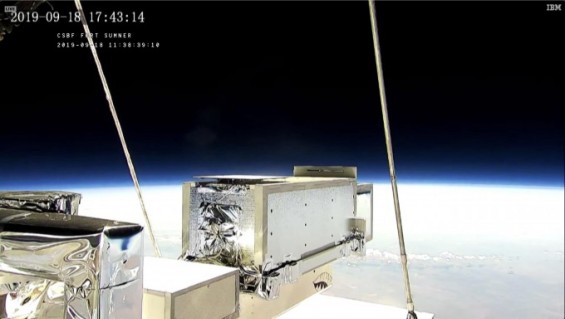
A corona graph being observed in the stratosphere on September 18, 2019 on a scientific balloon. Provided by cheonmunyeon.
Corona, the outermost region of the solar atmosphere, is known to have a darker light while its temperature is much higher than the surface. Corona also affects the Earth by releasing plasma, called the solar wind, throughout the solar system at high speed. The high temperature of the corona and the mechanism for accelerating the solar wind are a scientific challenge that has not yet been identified.
The Korea Astronomical Research Institute announced on the 18th that it has succeeded in obtaining the temperature and velocity of electrons in the solar corona area for the first time in the world by analyzing the observation result of the solar’coronagraph’ developed jointly with NASA.
Corona graph is a device that artificially covers the sun’s surface and observes corona. Due to atmospheric scattering from the ground, it is difficult to make precise observations. In September 2019, Cheon Mun-yeon and NASA loaded a corona graph onto a scientific balloon and sent it to the stratosphere at an altitude of about 40 km to begin observation.
As a result of observation through a corona graph sent to the stratosphere in September 2019, Chun Moon-yeon and NASA joint researchers reported that the solar corona temperature reached about 1 million degrees and the speed of the solar wind emitted from the corona was 260 km/sec. ‘It was released on January 12th.

A solar corona streamer obtained from a corona graph (a structure extending from the left to the right). The center circle is the part where the sun is covered, and you can check the external corona existing around the circle. (a) is the polarization brightness image, and the distribution of temperature (b) and particle velocity (c) in the same region can be seen. Provided by Korea Astronomical Research Institute.
The surface temperature of the sun is about 6000 degrees, but the temperature of the solar atmosphere, the corona, has been estimated to be between 1 million and 5 million degrees. If the heat from the inner core of the sun is transferred to the outside in order, the solar surface must be hotter than the corona, but the temperature of the corona is much higher than the solar surface. The observation of the joint researchers confirmed that the temperature of the corona is 1 million degrees. The joint research team is expected to find clues about the cause of the high temperature of the corona through this study.
Based on the core technology of the corona graph verified by this observation, Cheon Mun-yeon plans to develop a next-generation corona graph with NASA in the future and install it at the International Space Station (ISS) around 2023.
Dr. Nachimut Gopalswami, the head of the NASA side of the research, said, “The solar research is an important research that affects the whole life of mankind.” One achievement.”
“The development of a corona graph for ISS will open the way for low-cost and high-efficiency solar exploration research,” said Kim Yeon-han, a senior researcher.
